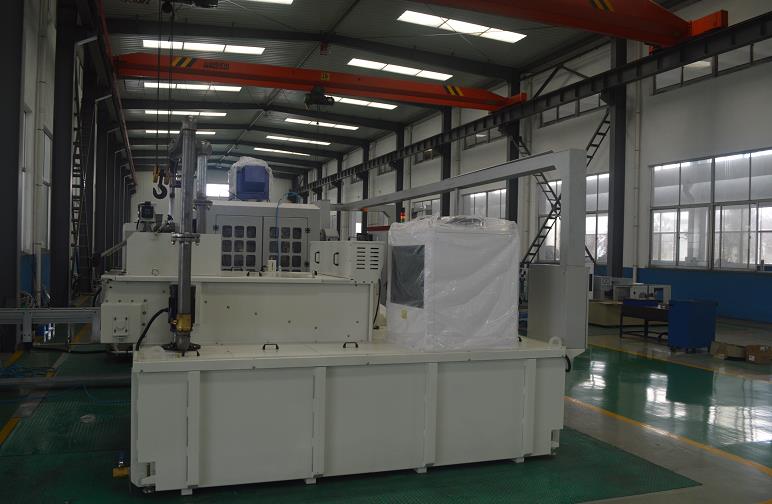Horizontal Reciprocating Double Face Grinder
1.Double endface grinding: The machine has two horizontally mounted grinding wheels that can grind on both sides of the workpiece simultaneously. This design allows for increased productivity and efficiency.
2.High precision: The machine is equipped with a precise positioning system and control to ensure accurate and repeatable grinding results. It can achieve tight tolerance requirements and parallelism requirements for applications that require high precision.
3.Wide range of applications: The machine can handle a variety of materials, including metals, plastics, ceramics, composites, etc. It is capable of grinding and finishing workpieces of different shapes and sizes, such as flat plates, bars, shafts, gears, etc.
Product description
The Horizontal Reciprocating Double Face Grinder is a specialized machine used for grinding and polishing surfaces on various types of materials. It is commonly used in industrial settings and is particularly useful for applications that require high precision and surface finish.
Project | unit | parameter |
Workpiece diameter | mm | 5-100 |
Workpiece thickness | mm | 10-80 |
Grinding wheel size (outer diameter× inner diameter× thickness) | mm | 500×300×63 |
Grinding head spindle speed | r/min | 1060 |
Grinding head moving stroke | mm | 120 |
Reciprocating stroke | mm | 500 |
Main motor power | kw | 15×2 |
Total power of motor | kw | 35 |
Machine tool weight | kg | 65000 |
Product process
The process of the Horizontal Reciprocating Double Face Grinder involves several steps to achieve precision grinding and polishing of surfaces. Here is a general overview of the process:
Workpiece placement: The workpiece is securely placed between the two grinding wheels or faces of the machine. It should be properly aligned and held in place to ensure accurate and consistent grinding results.
Grinding wheel selection: The appropriate grinding wheels are selected based on the material type, desired surface finish, and other specific requirements of the application. The wheels can vary in terms of grit size, hardness, and bond type to suit different grinding needs.
Machine setup: The machine is set up according to the specific requirements of the workpiece and application. This includes adjusting the grinding wheel speed, feed rate, and other operating parameters to achieve the desired grinding results.
Grinding operation: The grinding process begins with the simultaneous reciprocating movement of both grinding wheels. This back-and-forth motion ensures even material removal and uniform grinding across the entire surface of the workpiece.
Grinding force adjustment: The grinding force applied during the process can be adjusted to control the material removal rate and achieve the desired surface finish. This is typically done by adjusting the machine's pressure or feed rate.
Cooling and lubrication: Coolant or lubricant is often used during the grinding process to prevent overheating, reduce friction, and flush away debris. This helps to maintain the quality of the grinding surface and prolong the life of the grinding wheels.
Inspection and measurement: After the grinding process is complete, the workpiece is inspected for quality and dimensional accuracy. Measurements may be taken to ensure that the desired specifications and tolerances have been met.
Surface polishing (optional): Depending on the application, the Horizontal Reciprocating Double Face Grinder may also include a polishing step. This can involve using a different type of grinding wheel or polishing pad to achieve a smooth and reflective surface finish.
Product characteristics
1.Efficient material removal: The process of double end grinding has a faster material removal rate than other grinding methods. The alternating rotation of the double grinding wheels effectively increases the grinding area and improves the material removal rate.
2.Improved surface finish: The machine is designed to provide a high quality surface finish to the workpiece. It removes surface defects, such as burrs, scratches or pits, leaving a smooth, polished surface.
3.Automation Capability: The horizontal reciprocating double end grinder can be integrated with automation systems to increase productivity and reduce labor costs. It can be equipped with features such as automatic work piece loading and unloading, process measurement and feedback control to enhance the overall efficiency of the grinding process.
4.Operator-friendly design: The machine is designed to be user-friendly with easy-to-use controls. It incorporates safety features to protect the operator and ensure safe operation.
Application
Some common applications of the Horizontal Reciprocating Double Face Grinder include:
1.Precision grinding: This machine is capable of grinding and smoothing surfaces with high precision, making it suitable for applications where tight tolerances are required, such as in the automotive or aerospace industries.
2.Flat surface grinding: The double face design of this grinder enables simultaneous grinding on both sides of the workpiece, resulting in flat and even surfaces. This is often used for grinding large metal or plastic plates, ensuring smooth and parallel surfaces.
3.Surface preparation: The Double Face Grinder can be used for removing surface imperfections, burrs, and sharp edges. It is commonly used for preparing surfaces before further processing, such as painting, coating, or welding.
4.Lapping and polishing: With its reciprocating motion and adjustable grinding force, this grinder is also suitable for lapping and polishing applications. It can provide a high-quality, mirror-like surface finish on materials like metal, glass, ceramics, and composites.
5.Deburring and chamfering: The Horizontal Reciprocating Double Face Grinder can also be used for deburring or chamfering sharp edges on workpieces. This is particularly useful in metalworking industries, where the removal of burrs is crucial for safety and quality reasons.
6.Thickness control: Some models of the Horizontal Reciprocating Double Face Grinder are equipped with thickness control features, allowing for precision grinding of workpieces to achieve specific thickness requirements.
Overall, the Horizontal Reciprocating Double Face Grinder is a versatile machine that finds application in various industries, where precision, surface finish, and flatness are important requirements. It can improve productivity, ensure uniform quality, and enhance the overall efficiency of surface grinding processes.









